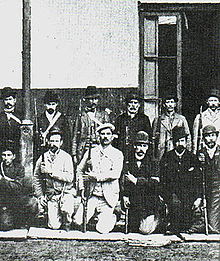| Revolution of 1893 | |||||||||||
|---|---|---|---|---|---|---|---|---|---|---|---|
 | |||||||||||
| |||||||||||
| Government-Insurgents | |||||||||||
|
|
| ||||||||||
| Commanders and leaders | |||||||||||
|
|
| ||||||||||
The Argentine Revolution of 1893, or the Radical Revolution of 1893, was a failed insurrection by members of the Radical Civic Union (UCR) against the government of Argentina, then controlled by the National Autonomist Party (PAN). It continued the goals of the Revolution of the Park of 1890, whose themes were further echoed in the Revolution of 1905.
In 1890, Bartolomé Mitre and Leandro N. Alem formed the Civic Union, which orchestrated the Revolution of the Park and forced the resignation of president Miguel Ángel Juárez Celman of the PAN in favor of his vice president, Carlos Pellegrini. Mitre himself stood for president for the 1892 elections, but sought accommodation with the PAN, leading Alem to break off and found the UCR in 1891. On April 2, 1892, barely a week before the election, Pellegrini declared a state of siege and arrested Alem and other opposition leaders, resulting in the overwhelming election of PAN candidate Luis Sáenz Peña.
In the aftermath, the UCR split into factions led by Alem (los líricos, "the Lyricists") and by his nephew and protégé, Hipólito Yrigoyen (los rojos, "the Reds"). Yrigoyen and his political brother Aristóbulo del Valle believed the UCR should take power through provincial rebellions, as opposed to a coup d'état of the national government.[1]
- ^ Cabral, 536